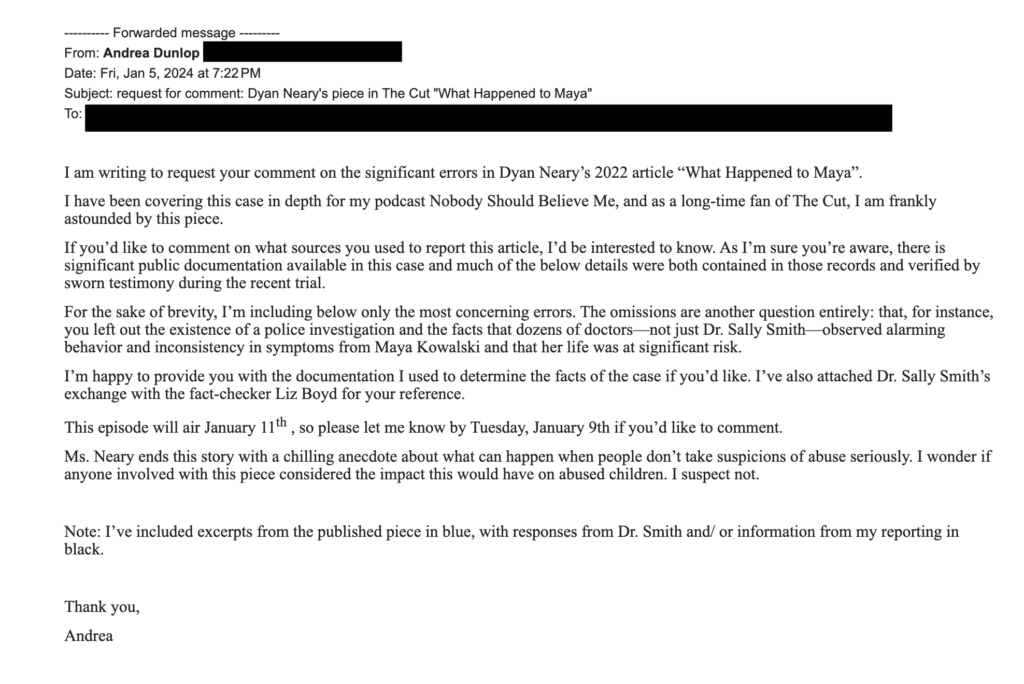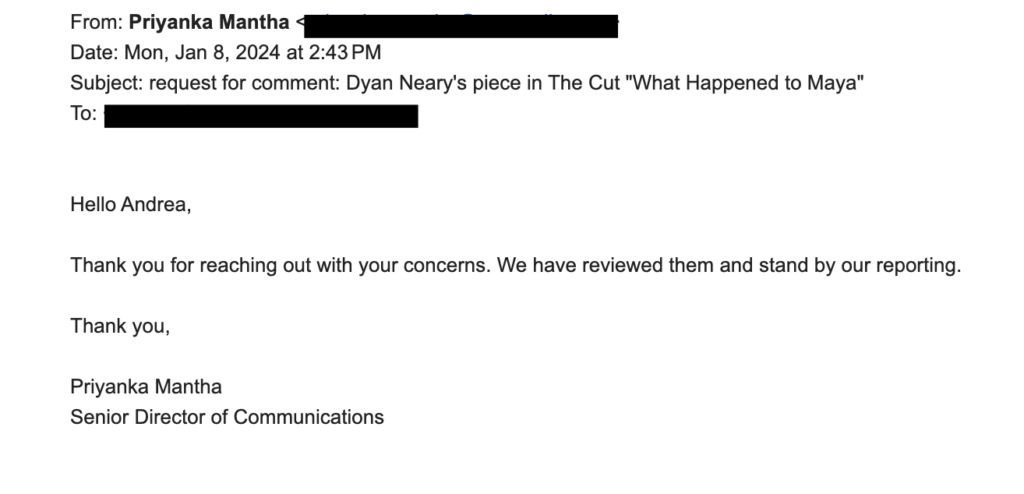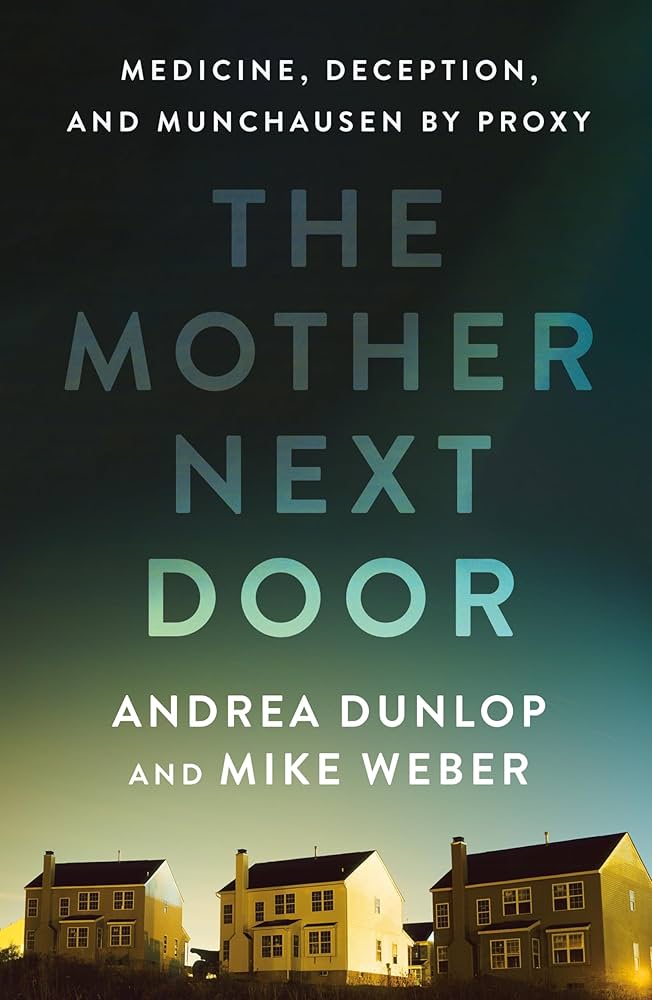I reached out to New York Magazine about the numerous and significant errors in their 2022 piece. Below is my note to them and the response from their senior director of communications.

Smith, who retired this summer, tended to interpret cases aggressively. Children in Pinellas are removed from their homes at one of the highest rates of Florida’s 67 counties, and Smith said this is because the child-protection team she directed does “a more thorough, higher-quality job.”
Sally’s response to the fact-checker:
Incorrect – The county with the highest rate of out of home placement of children as a result of child protective investigations varies from year to year. The removal rate per 100 alleged victims for Pinellas County has not been the highest in the state for any of the last 5 years. (https://www.myflfamilies.com/service-programs/childwelfare/lmr/docs/2021LMRs/Annual_Performance_Report_2020- 21.pdf) Many out of home placements are deemed necessary by the court as a result of environmental hazards, poverty, addiction and other components of Child Neglect that threaten the safety of a child. Investigations for such children often do not involve a CPT medical evaluation. I recall discussing with Dyan that “I don’t know” why one county might have a higher rate than another, but it would likely be multi-factorial and we discussed multiple elements that might come into play including differences in judicial circuits, community services, in-home care options, repeated investigations for a family and comprehensive assessments.
The pain baffled everyone. The Kowalskis took Maya to All Children’s, but the staff was unable to come up with a diagnosis. Doctors at yet another hospital, Tampa General, thought that Maya’s muscle weakness could be explained by an oral steroid she’d been prescribed for her asthma. Then one of Beata’s patients, whose child suffered from an acute pain condition, recommended that they consult a local anesthesiologist named Anthony Kirkpatrick, who ran a center in Tampa that studied CRPS.
None of this is correct. The pain did not “baffle everyone”, both Lurie’s Childrens in Chicago and Tampa General Hospital where Maya spent a diagnosed Maya with conversion disorder, though there was also a suspicion of steroid induced myopathy from the immense does of steroids Maya had been taking for her allegedly life-threatening asthma (another claim that doesn’t hold up to the records), this was ruled out by Lurie’s. Also, as Beata told pulmonologist Dr. Kriseman a week before seeing Kirkpatrick for the first time that Maya had RSD (CRPS) it appears this is diagnosis she was seeking out. Worth mentioning too that Dr. Kirkpatrick is not bored certified in anesthesiology or in anything else for that matter.
Maya still required a wheelchair, but the ketamine led to “huge progress,” Jack says. Maya’s feet straightened, the lesions healed, and there were periods when her distress seemed manageable.
This “huge progress” is disputed by the medical records from this time period, as well as Beata’s own accounts on the blog she maintained in Maya’s voice and in her email exchanges with Dr. Kirkpatrick. Maya received a ketamine coma procedure during this time and 55 rounds of ketamine infusions from Dr. Hana. The family was fundraising with their church to send her back to Mexico for a second coma treatment in April of 2016.
Smith found the stories unconvincing. In her report to DCF, she wrote that Beata “veered off regarding herself getting ‘no sleep for weeks’ and the struggles of ‘working to maintain insurance.’” On October 11, Kirkpatrick’s office received a request for Maya’s medical records, and he asked to speak to the person conducting the investigation. When Smith called him back, she told him that she believed Maya was a victim of child abuse. The doctor reminded Smith that he had been the one to first diagnose Maya with CRPS; he’d also recommended the procedure in Mexico.
Please see below statements from Dr. Smith:
None of the above were told to me by Mr or Mrs. Kowalski, so I would not have characterized those comments in any manner in a report.
Incorrect – None of the above is accurate. In assessing a child for Medical Child Abuse, a child abuse pediatrician should gather and review all available medical records and consider the totality in reaching a diagnostic impression. Termination of a complex medical evaluation at a very early stage based on commentary from 1 or 2 providers would have been irresponsible as a CPT Medical Director.Dr. Kirkpatrick is listed online as the Chair of the International Research Foundation for Reflex Sympathetic Dystrophy RSD/CRPS in Tampa and reports that he has sent hundreds of children and adults he has diagnosed with “RSD/CRPS” to Germany and Mexico for treatments that are not approved in the United States over the past 20 years. This includes referrals to Mexico for “Ketamine Coma” in which patients are given increasing daily doses from 5000 to 12000 mg of ketamine over 5 days. Multiple published studies have indicated some evidence for short-term efficacy of IV ketamine treatment of Complex Regional Pain Syndrome at maximum daily doses of 100 to 200 mg for an adult. A physician’s advocacy for unconventional treatments particularly for a child would be something I would take into consideration in assessing that physician’s credibility in an alleged Medical Child Abuse scenario. Similarly, if it was determined that Dr. Hanna had given a child in an outpatient setting 1000 mg of ketamine combined with high doses of midazolam, ondansetron, magnesium sulfate, glycopyrrolate and diphenhydramine on dozens of occasions, that would be something I would take into consideration in a
One method of supporting a Munchausen-by-proxy diagnosis is a separation test: Remove the child from the offending parent and see if her health dramatically improves. But as weeks went by with Maya isolated, she continued to report extreme pain. Smith, still not buying the CRPS story, began to wonder if something besides Munchausen by proxy could explain what was happening. She instructed doctors to secretly videotape Maya and asked nurses to try to catch the girl moving her legs. “I just went to see Maya,” one hospital employee texted Smith. “I watched her use her feet to push herself several feet in her wheelchair … She was distracted and I’m not even sure she realized she did it bc i didn’t call attention to it.” Smith replied, “Fortunately at 10 years old she can’t perform the charade effectively 24/7. And doesn’t even know if she’s making ‘physiological’ mistakes. I’m coming to take some pictures of her ‘affected’ legs.”
By December, a hospital pediatrician had changed Maya’s diagnosis from Munchausen by proxy to factitious disorder. It meant that Smith and the doctors no longer suspected that her parents were causing her illness. It was an accusation that Maya was making everything up.
This is inaccurate. They never changed the diagnosis and the criminal and DCF investigations into Beata were ongoing at the time of Beata’s death. JHAC suspected there might be elements of Factitious disorder, but the working diagnosis was conversion disorder, just as it had been at Lurie’s and Tampa General Hospital.
Even when All Children’s accepted Smith’s finding that Maya was faking her condition — going so far as to say that the strange bumps and lesions that continued to appear on her arms, legs, and forehead were self-inflicted — it did not alter her custody status, and she remained separated from her parents. That was lucrative for the hospital. In the months that Maya was forced to remain there, All Children’s billed her insurer more than $650,000 for her treatments, including 174 entries for CRPS, the malady Maya supposedly didn’t have.
None of this is true. There was an active police investigation for medical child abuse and they never “determined Maya was faking”. Also, Jack had supervised visitation from early on. Your assertion that this was “lucrative” for the hospital is absurd. They were providing her treatment for conversion disorder—which incidentally overlaps almost entirely with the accepted modality of CRPS treatment—which three separate hospitals has diagnosed, and JHAC never definitively ruled out CRPS because they were unable to get a neutral expert to evaluate the child during her stay. You can see that in her discharge paperwork. Also, numerous experts testified at trial that Maya’s “lesions” were scratches.
Contrary to the hospital’s suspicions, Beata had never been diagnosed with a mental illness, and prior to the DCF investigation, Jack says, she’d never suffered from depression. She had even undergone a court-ordered evaluation by a licensed psychologist who found “no evidence that would support the conclusion that Beata has falsified her daughter’s medical condition for any psychological purpose” and who concluded that “factitious disorder by proxy may safely be ruled out.” The psychologist did note that Beata may have been suffering from an “adjustment disorder” resulting from Maya’s illness and removal from their home. (Another report, written by Teppa Sanchez, observed: “Mother states that she is extremely tired and is very stressed and at times feels like she ‘wants to die.’”)
This psychologist Dr. Tashawna Duncan, was hired by the Kowalski’s attorney and determining whether or not medical child abuse took place requires a comprehensive record review, preferably done by a child abuse pediatrician. You cannot determine whether someone has abused their child by doing a psychological evaluation. Also, this psychologist’s idea that Maya having CRPS “rules out” MBP/ medical child abuse is entirely incorrect. Please see APSAC’s practice guidelines below for reference.
https://www.apsac.org/9235fgnl8
He ruled that Jack could take Maya to Rhode Island to be evaluated by Pradeep Chopra, a professor at Brown University’s medical school who studies CRPS. Later, after Chopra wrote that Maya’s symptoms and response to treatments were consistent with CRPS, and that the diagnoses of Munchausen by proxy and factitious disorder were “incorrect,” Haworth remanded Maya back to Jack’s custody.
This is extremely misleading at best. Judge Hayworth released Maya to Jack’s custody because Beata wad dead. He allowed Jack to take Maya to see Dr. Chopra—an expert Beata had found and chosen before her death—but that had nothing to do with his decision to let Maya leave JHAC, which came down before Maya saw Dr. Chopra. I’m happy to provide you a copy of judge’s order.
When Maya left All Children’s Hospital in January 2017, she weighed less than she did when she was admitted — a dark verdict on the separation test meant to detect Munchausen by proxy. She was so weak that it was difficult for her to sit up on her own, and Jack remembers having to put stuffed animals in the back seat of the car to support her body.
This is inaccurate. According the hospital’s discharge summary, she’d gained weight in the hospital. Maya had been weaned off of ketamine and many of other medications, and despite never going back on it, she has continued to improve ever since.
Smith was never one of Maya’s treating doctors, and on the day she opened her confidential records, there was no active DCF investigation. HIPAA violations are punishable by significant fines and up to ten years in prison. When I asked All Children’s about how child-abuse pediatricians like Smith are able to access patient records, the hospital did not answer. (Smith disputed that any HIPAA violation occurred.)
This is truly egregious. See Dr. Smith’s comment to Liz Boyd below where she explains the exemption to HIPPA that covers consulting with a CPT. I was also to verify this one my own long before talking to Dr. Smith.
8. After this phone call, you logged into an internal All Children’s portal and began
reading through Maya’s medical records. We understand that this is a HIPPA
violation. Why did you have access to these records? Any comment on this?
Incorrect –
As a member of the JHACH Active Medical Staff who is
consulted regarding a child in the hospital, it is legal, appropriate and
typical that the consulted specialist would review medical records for
the involved child. This is not a HIPPA violation.




